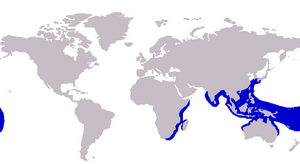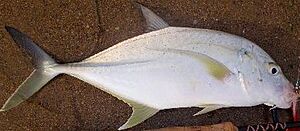Brassy trevally facts for kids
Quick facts for kids Brassy trevally |
|
|---|---|
 |
|
| Caranx papuensis from French Polynesia | |
| Conservation status | |
| Scientific classification | |
 |
|
| Approximate range of the brassy trevally | |
| Synonyms | |
|
The brassy trevally, also known as Caranx papuensis, is a large ocean fish. It belongs to the jack family, called Carangidae. People also call it the brassy kingfish, Papuan trevally, tea-leaf trevally, or green back trevally.
Contents
About the Brassy Trevally's Name
The brassy trevally is part of a group of fish called Caranx, which are also known as jacks or trevallies. This group is part of the bigger jack and horse mackerel family, Carangidae.
Two Australian zoologists, Haynes Gibbes Alleyne and William John Macleay, first described this fish in 1877. They found a specimen, which is a sample, near Papua New Guinea. They named it Caranx papuensis. The name papuensis comes from Papua New Guinea, where the fish was found. Other scientists later gave it different names, like Caranx regularis and Caranx celetus, but Caranx papuensis is the official name.
People often call this fish the brassy trevally because of its color. Other common names like tea-leaf trevally or greenback trevally also refer to its look. The name Papuan trevally comes from where it was first discovered.
What Does the Brassy Trevally Look Like?
The brassy trevally is a big fish. It can grow up to 88 centimeters (about 35 inches) long and weigh as much as 6.4 kilograms (about 14 pounds).
As its name suggests, the top part of the fish is a brassy or yellowish-green color. Its belly is silvery-white. Young brassy trevallies are usually all silver. The head and upper body of the fish have many small black spots. These spots become more common as the fish gets older. It also has a bright, silvery-white spot with black edges near its shoulder.
Its fins are usually yellow or dusky, except for the tail fin. The upper part of the tail fin is dusky, and the lower part is dusky or yellow. The tail also has a thin white line on its back edge.
This fish often looks like the giant trevally, Caranx ignobilis. However, you can tell them apart because the brassy trevally has lighter colors on its back and many more black spots.
Like other jacks, the brassy trevally has a body that is somewhat flat from side to side. Its back is more curved than its belly. It has two dorsal fins on its back. The first has eight stiff spines, and the second has one spine and 21 to 23 soft rays. The anal fin on its underside has two separate spines, then one spine and 16 to 19 soft rays. Its pelvic fins have one spine and 19 to 20 soft rays.
The fish has a special line along its side called the lateral line. This line helps it sense movement in the water. It also has strong, bony plates called scutes near its tail. The brassy trevally has small adipose eyelids, which are fatty eyelids. Its teeth include widely spaced canine teeth and smaller, brush-like teeth in the upper jaw. It has 26 to 30 gill rakers, which help it filter food, and 24 vertebrae (backbones).
Where Do Brassy Trevallies Live?
The brassy trevally lives in warm, tropical, and subtropical waters. You can find it in the Indian Ocean and the western parts of the Pacific Ocean.
Its range stretches from South Africa and Madagascar along the coast of East Africa. However, it is not found in the Red Sea or Persian Gulf. You can find it from India all the way through Southeast Asia, the Malay Archipelago, and many islands in the Indian and East Pacific Oceans. It lives as far south as Sydney, Australia and as far north as the Ryūkyū Islands in Japan. Its range also extends east to the Marquesas Islands in the central Pacific.
What Kind of Places Do They Live In?
Brassy trevallies live in both coastal areas near the shore and deeper waters farther out. Adult fish usually live near reefs or deep underwater peaks. They can also be found near rocks in sandy bays and lagoons.
Young brassy trevallies often live in tidal creeks lined with mangrove trees, especially where the water is cloudy. They are also found in estuaries, which are places where rivers meet the sea. Sometimes, they even swim far up into rivers.
How Do Brassy Trevallies Live?
The brassy trevally is a predator, meaning it hunts other animals for food. It travels alone or in small groups. It eats various prey, including small fish, squid, prawns, and crabs.
Studies in estuaries in South Africa found that young brassy trevallies mostly eat crustaceans, like crabs and shrimp. As they grow older, they start eating more fish. We don't know much about other parts of their lives, like how they reproduce or how they move around. However, fishing data shows that more brassy trevallies are caught in South Africa during the summer.
Like other fish, the brassy trevally can have different parasites. These can be inside the fish, like a type of worm called Prosorhynchoides lamprelli found in its gut. They can also be outside, like a tiny worm called Lethacotyle vera that lives on its gills.
How Do People Interact with Brassy Trevallies?
The brassy trevally is not a very important fish for large commercial fisheries. It is often caught by accident when people are fishing for other species using nets or hooks. There are no specific records of how many brassy trevallies are caught each year.
However, this fish is somewhat important to people who fish for fun, called recreational fishermen. It is considered a good gamefish and can be caught using various baits, lures, and flies. Even so, anglers usually don't specifically try to catch brassy trevallies. They often prefer bigger fish like giant trevally. So, the brassy trevally is usually caught by chance and often released. Spearfishermen also commonly catch this fish.
Many people think the brassy trevally is an excellent fish to eat. Some aquariums have kept brassy trevallies in large saltwater tanks. Reports from the Reunion Island Aquarium show that these fish can get used to living in an aquarium, but they need a very big tank. The biggest brassy trevally ever caught by an angler, according to the IGFA, weighed 7.90 kilograms (17 pounds 6 ounces). It was caught off Bazaruto Island, Mozambique, in 2008.
See also
 In Spanish: Caranx papuensis para niños
In Spanish: Caranx papuensis para niños




